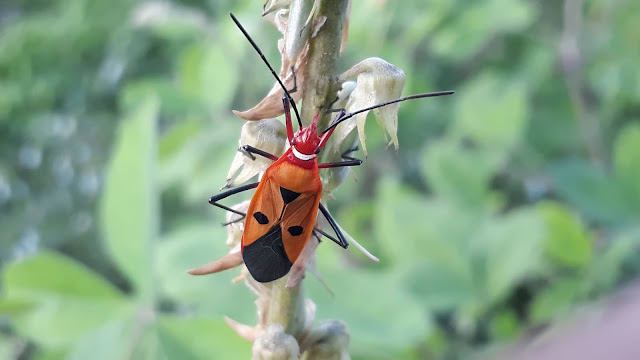Golden Tortoise Beetle (Charidotella sexpunctata): Scientific Classification, Habit and Habitat, Identifying Characters
Golden Tortoise Beetle (Charidotella sexpunctata): Scientific Classification, Habit and Habitat, Identifying Characters
Scientific
Classification
Kingdom: Animalia
Phylum: Arthropoda
Class: Insecta
Order: Coleoptera
Suborder: Polyphaga
Family: Chrysomelidae
Subfamily: Cassidinae
Tribe:
Cassidini
Genus: Charidotella
Species: sexpunctata
Habit
and Habitat:
- Commonly seen under the leaves of host plants.
- Under sunshine, they appear to shine with the metallic golden color.
Food Habit: Feed only on a specific family of plants, the
Convolvulaceae which include Sweet potato (Ipomoea batatas), Morning
glory (Ipomoea spp.), Bindweed (convolvulus spp.)
Identifying
Characters:
Adults:
- Size: 10-30mm long and 9-13mm wide.
- Margins of prothorax and elytra are expanded, largely concealing the head and appendages.
- The expanded margins are not pigmented, appearing nearly transparent.
- The body is metallic golden in color but sometimes may appear bronzed or even reddish. The golden color is lost when the insect dies.
- The eggs are attached singly to the underside of leaves or stems, and are white in color.
- The eggs are elongated measuring 1.5- 2mm long and hatch in five to 10 days.
- Larvae are broad and flattened and adorned with branched spines.
- Their thoracic legs are short and thick and lack an anal proleg.
- The larvae display the habit of carrying their cast skins and fecal material attached to spines arising from the posterior end of their body, a structure called anal fork.
- Anal fork is movable, and usually used to hold the debris over the back of the body, forming a shield which deters predation.
- Larvae mature in 14-21 days.
- The mature larvae attach themselves to leaves by their anal end and pupate.
- Pupa are brownish in color and bear spines.
- The fecal material and other debris carried by the larval stage may also remain attached to the pupa.
- The pupae measure 5-8 mm in length. The duration of the pupal stage is usually 7-14 days.



nice...keep it up
ReplyDelete